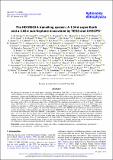The HD 93963 A transiting system: A 1.04 d super-Earth and a 3.65 d sub-Neptune discovered by TESS and CHEOPS
| dc.contributor.author | Seager, Sara | |
| dc.date.accessioned | 2023-03-07T18:38:09Z | |
| dc.date.available | 2023-03-07T18:38:09Z | |
| dc.date.issued | 2022 | |
| dc.identifier.uri | https://hdl.handle.net/1721.1/148402 | |
| dc.description.abstract | We present the discovery of two small planets transiting HD 93963 A (TOI-1797), a G0 V star (M⋆ = 1.109 ± 0.043 M⊙, R⋆ = 1.043 ± 0.009 R⊙) in a visual binary system. We combined TESS and CHEOPS space-borne photometry with MuSCAT 2 ground-based photometry, ‘Alopeke and PHARO high-resolution imaging, TRES and FIES reconnaissance spectroscopy, and SOPHIE radial velocity measurements. We validated and spectroscopically confirmed the outer transiting planet HD 93963 A c, a sub-Neptune with an orbital period of Pc ≈ 3.65 d that was reported to be a TESS object of interest (TOI) shortly after the release of Sector 22 data. HD 93963 A c has a mass of Mc = 19.2 ± 4.1 M⊕ and a radius of Rc = 3.228 ± 0.059 R⊕, implying a mean density of ρc = 3.1 ± 0.7 g cm−3 . The inner object, HD 93963 A b, is a validated 1.04 d ultra-short period (USP) transiting super-Earth that we discovered in the TESS light curve and that was not listed as a TOI, owing to the low significance of its signal (TESS signal-to-noise ratio ≈6.7, TESS +CHEOPS combined transit depth Db = 141.5 +8.5 −8.3 ppm). We intensively monitored the star with CHEOPS by performing nine transit observations to confirm the presence of the inner planet and validate the system. HD 93963 A b is the first small (Rb = 1.35 ± 0.042 R⊕) USP planet discovered and validated by TESS and CHEOPS. Unlike planet c, HD 93963 A b is not significantly detected in our radial velocities (Mb = 7.8 ± 3.2 M⊕). The two planets are on either side of the radius valley, implying that they could have undergone completely different evolution processes. We also discovered a linear trend in our Doppler measurements, suggesting the possible presence of a long-period outer planet. With a V-band magnitude of 9.2, HD 93963 A is among the brightest stars known to host a USP planet, making it one of the most favourable targets for precise mass measurement via Doppler spectroscopy and an important laboratory to test formation, evolution, and migration models of planetary systems hosting ultra-short period planets. | en_US |
| dc.language.iso | en | |
| dc.publisher | EDP Sciences | en_US |
| dc.relation.isversionof | 10.1051/0004-6361/202243093 | en_US |
| dc.rights | Creative Commons Attribution 4.0 International license | en_US |
| dc.rights.uri | https://creativecommons.org/licenses/by/4.0/ | en_US |
| dc.source | EDP Sciences | en_US |
| dc.title | The HD 93963 A transiting system: A 1.04 d super-Earth and a 3.65 d sub-Neptune discovered by TESS and CHEOPS | en_US |
| dc.type | Article | en_US |
| dc.identifier.citation | Seager, Sara. 2022. "The HD 93963 A transiting system: A 1.04 d super-Earth and a 3.65 d sub-Neptune discovered by TESS and CHEOPS." Astronomy and Astrophysics, 667. | |
| dc.contributor.department | Massachusetts Institute of Technology. Department of Earth, Atmospheric, and Planetary Sciences | en_US |
| dc.relation.journal | Astronomy and Astrophysics | en_US |
| dc.eprint.version | Final published version | en_US |
| dc.type.uri | http://purl.org/eprint/type/JournalArticle | en_US |
| eprint.status | http://purl.org/eprint/status/PeerReviewed | en_US |
| dc.date.updated | 2023-03-07T18:34:18Z | |
| dspace.orderedauthors | Serrano, LM; Gandolfi, D; Hoyer, S; Brandeker, A; Hooton, MJ; Sousa, S; Murgas, F; Ciardi, DR; Howell, SB; Benz, W; Billot, N; Florén, H-G; Bekkelien, A; Bonfanti, A; Krenn, A; Mustill, AJ; Wilson, TG; Osborn, H; Parviainen, H; Heidari, N; Pallé, E; Fridlund, M; Adibekyan, V; Fossati, L; Deleuil, M; Knudstrup, E; Collins, KA; Lam, KWF; Grziwa, S; Salmon, S; Albrecht, SH; Alibert, Y; Alonso, R; Anglada-Escudé, G; Bárczy, T; Barrado y Navascues, D; Barros, SCC; Baumjohann, W; Beck, M; Beck, T; Bieryla, A; Bonfils, X; Boyd, PT; Broeg, C; Cabrera, J; Charnoz, S; Chazelas, B; Christiansen, JL; Collier Cameron, A; Cortés-Zuleta, P; Csizmadia, S; Davies, MB; Deline, A; Delrez, L; Demangeon, ODS; Demory, B-O; Dunlavey, A; Ehrenreich, D; Erikson, A; Fortier, A; Fukui, A; Garai, Z; Gillon, M; Güdel, M; Hébrard, G; Heng, K; Huang, CX; Isaak, KG; Jenkins, JM; Kiss, LL; Laskar, J; Latham, DW; Lecavelier des Etangs, A; Lendl, M; Levine, AM; Lovis, C; Lund, MB; Magrin, D; Maxted, PFL; Narita, N; Nascimbeni, V; Olofsson, G; Ottensamer, R; Pagano, I; Pessanha, ACSV; Peter, G; Piotto, G; Pollacco, D; Queloz, D; Ragazzoni, R; Rando, N; Ratti, F; Rauer, H; Ribas, I; Ricker, G; Rowden, P; Santos, NC; Scandariato, G; Seager, S; Ségransan, D; Simon, AE; Smith, AMS; Steller, M; Szabó, GM; Thomas, N; Twicken, JD; Udry, S; Ulmer, B; Van Grootel, V; Vanderspek, R; Viotto, V; Walton, N | en_US |
| dspace.date.submission | 2023-03-07T18:34:21Z | |
| mit.journal.volume | 667 | en_US |
| mit.license | PUBLISHER_CC | |
| mit.metadata.status | Authority Work and Publication Information Needed | en_US |
